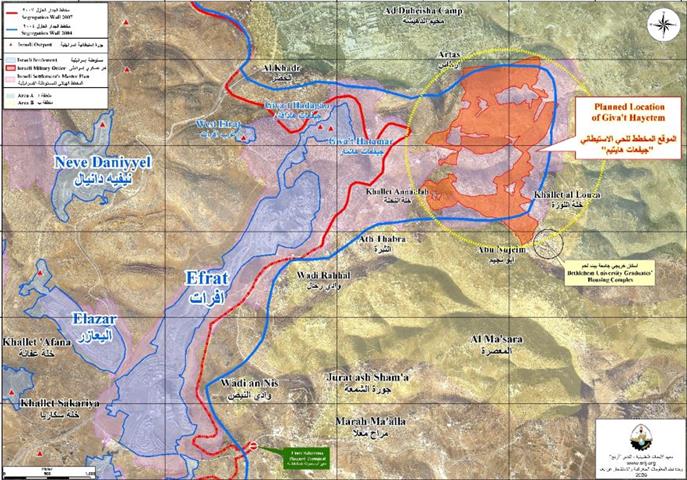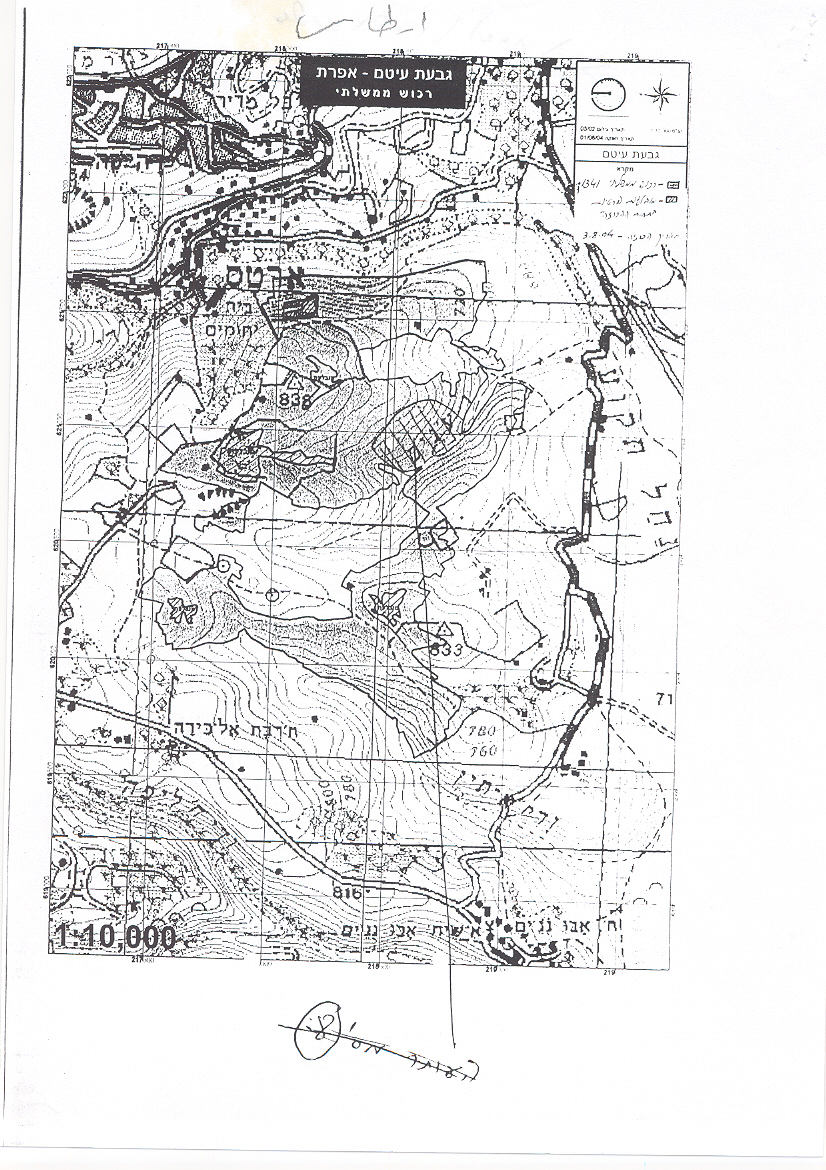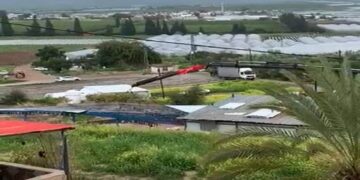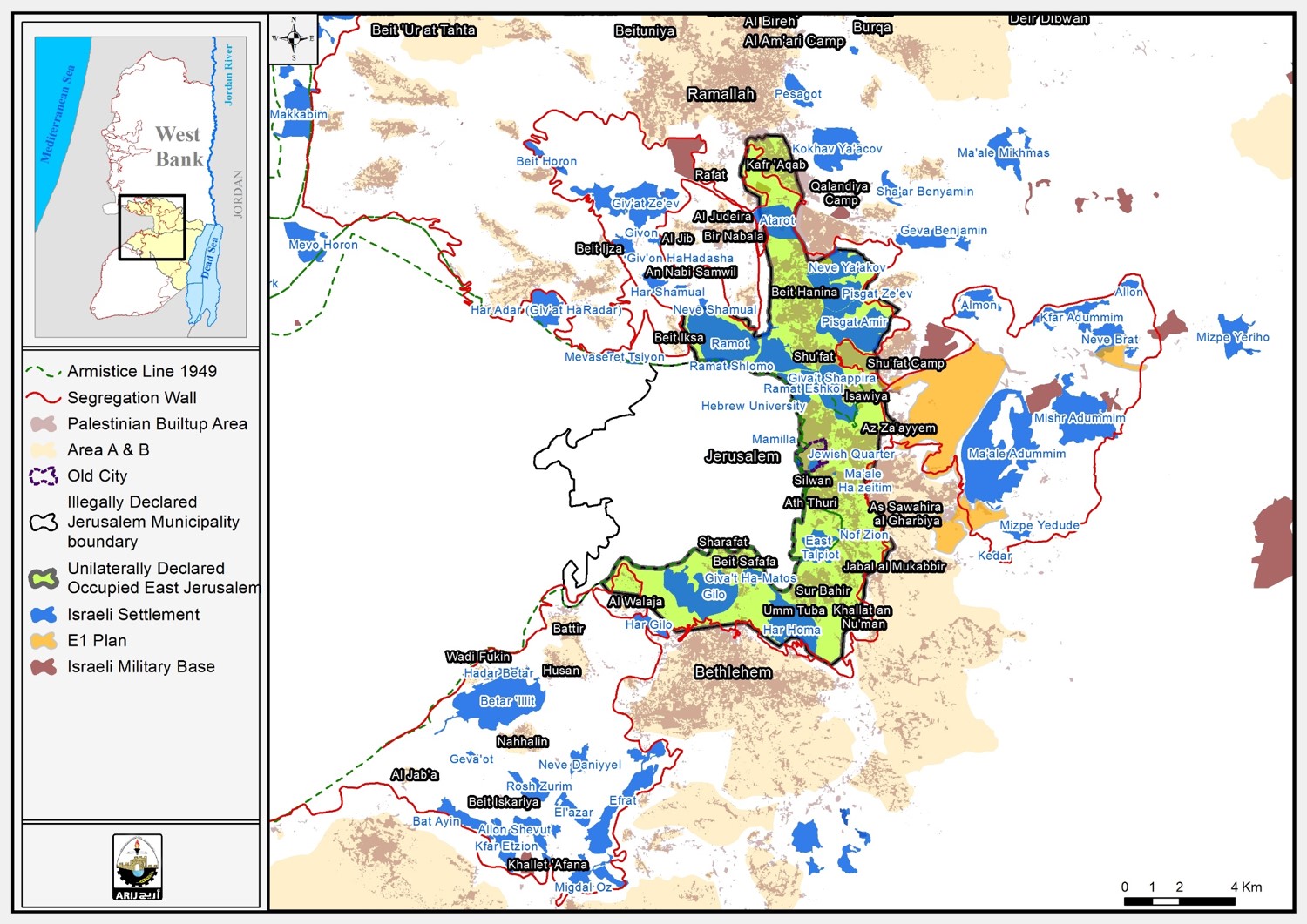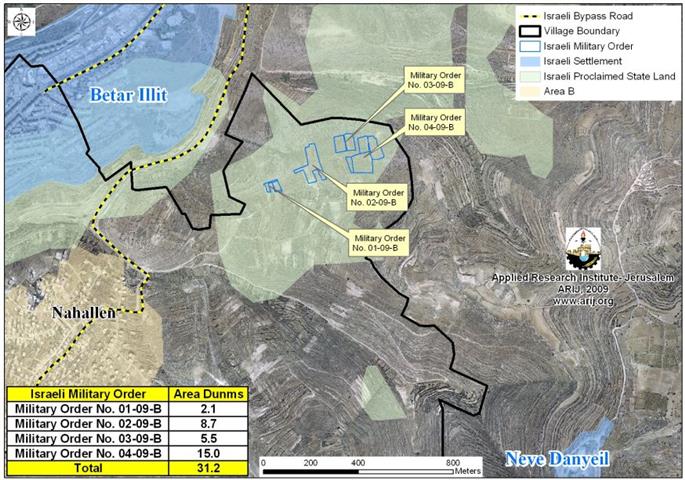The Israeli military court affiliated to the Israeli Civil Administration in Bethlehem Governorate rejected in mid February 2009 Eight of nine petitions filed by Palestinian citizens from Al Khader and Artas villages southwest of Bethlehem city against an Israeli Military Order issued back in 2004, which stated the seizure of 1700 dunums of Palestinian lands, and allegedly declared as 'State Land'. See Map 1
A thorough analysis of the military order conducted by the Applied Research Institute – Jerusalem showed that the targeted lands are located within the master plan of Efrat settlement southwest of Bethlehem city. The targeted land does not fall within the land areas isolated by the Segregation Wall at the Gush Etzion area; and even though Efrat settlement is within that settlements’ bloc, the area declared as state land falls out of the isolated lands. However, and now with the Israeli civil administration confirming the seizure of the land, thing might have take a reverse route, meaning that it is likely that the Israelis will go back to the planned route for the segregation wall as it was back in 2005; at least with regard to the Etzion settlements’ bloc. See Copy of military order
In Year 2005, the Israeli ministry of Defense made changes in several sections of the segregation wall in the West Bank Territory, one of which was the section where the area declared by Israel as state land north of Efrat settlement. According to the Israeli version, the targeted land is located to begin with, within the master plan set for Efrat settlement.
Reviving Dormant Plans
The Israeli rule confirming the seizure of the targeted land went to revive a plan at the same location to build an additional neighborhood for Efrat settlement, at the targeted land, which the settlement council of Efrat calls the “eighth hill” and the planned neighborhood name is 'Giv'at Hayetim.' The initial plans for the neighborhood is to construct 2500 housing units, and the project received preliminary approvals but it did not proceed any further as several other needed approvals needed to be secured; mainly from the Israeli Prime, the Israeli Minister of Defense, and the Israeli Minister of Housing, and when changes were made to the route of the segregation wall back in 2005, the project was put to rest. All of this has changed on mid-February 2009. What sparked the neighborhood project on the eightieth hill of Efrat settlement were two parallel aftermaths; first, the confirmed ruling of 1700 Dunums as state land, the second would be the rise of the Likud party back to power again in Israel.
These happenings
The general atmosphere following Israel's war on the Gaza Strip (The Cast Lead Operation) has pumped life again in the hearts of the Israeli right wings parties and nurtured their chances to rise to power for the next Israeli government (which is exactly what happened in the Israeli elections on February 10, 2009) and this has revived the hope in the hearts of the Israeli right wings parties members and the Israeli settlers to carry out their plans in the West Bank Territory. Consequently, the fact that the next Israeli government is going to be overwhelmed by the right wing parties will increase the chances that the next Israeli Prime, the Israeli Minister of Defense, and the Israeli Minister of Housing to support Efrat settlement council’s plan to build the new 2500 housing units neighborhood on the eighth hill of Efrat settlement.
The Rise of Netanyahu … Back to “Quid pro Quo” policy
This is not the first time that Benjamin Netanyahu would be prime minister of Israel. He is well known for his rigged policy toward the peace process with the Palestinians. For him, Jerusalem and the settlements are not on the negotiating table with the Palestinians, and he is only willing to give as little as possible from the occupied territory just enough for the Palestinian to live in, which pretty much where the Palestinian built-up areas stand today. He refuses to debate the settlements issue, as they are illegal, and is unwilling to freeze settlements’ building and expansions. As for the principle on which the peace process is based on 'land for peace' it is an abolished one. accordingly, in 1997 when Netanyahu was in power, he struck unwritten deal with the US Administration in which the Hebron agreement (H1 & H2) was concluded as the saying go “quid pro quo” the infamous 'Har Homa' settlement was built on the Palestinian Abu Ghneim mountain north of Bethlehem City.
Netanyahu 2009: a possible new deal in the horizon:
Giv'at Hayetim neighborhood in Return for the E1 plan
At the time the peace process is facing what maybe irreversible setback; along with the Israeli right wing party, headed by Benjamin Netanyahu, is headed toward power in Israel, the Israeli settlements’ activity are becoming more vigorous in all West Bank Territory; particularly in the occupied city of Jerusalem. A relentless Israeli led house demolition campaign against Palestinians’ houses at a time when the Israeli building activities is on the rise. Israel is yet about to finalize the preparations of the infrastructure of the long held neighborhood, the (E1), location (between Ma'ale Adumim settlement and Jerusalem city), and chances that construction will start are on the rise despite the outspoken US Administration and the international community opposition of the plan for years.
However, it seems that Netanyahu will look for a rerun of the 1997 “H1 & H2” – 'Har Homa' settlement deal but this time the deal would go for the (E1) plan in return (and we are speculating here) for cancelling out 'Giv'at Hayetim' neighborhood on eighth hill of Efrat settlement, with an additional pitches; maybe keeping the Palestinian Al-Bustan neighborhood in Silwan.
Focusing settlements' activities in and around Jerusalem, is an Israeli policy no matter who is in command in Israel; that is an issue agreed on by all the political parties in Israel (Right and left Wings) and they have made it clear in words and actions since the beginning of the peace process, especially when it came to Ma'ale Adumim and its surroundings including the E1 location; they stated that it will remain within the Israeli borders under any peace agreement with the Palestinians.
Former Prime Minister Yitzchak Rabin: 'Jerusalem and outlying areas cannot be defined by us as a political issue or as a security issue,' Rabin declared soon after taking office in 1992. 'United Jerusalem under Israeli sovereignty will remain our capital forever. For us it is the heart and the soul of the Jewish people.' (1992)
Former Deputy Defense Minister Mordechai Gur: 'Ma'ale Adumim is part of Jerusalem.' (October 1992):
Former Prime Minister Ehud Barak : 'We will continue to strengthen Ma'ale Adumim. Every house that is being built [in Ma'ale Adumim] is part of the State of Israel forever, period. In any permanent agreement, you will continue to be part of Israel. I say you are part of Jerusalem.' (Jerusalem Post, Sept.15, 1999)
Prime Minister Ariel Sharon:
-
'Ma’ale Adumim is one of the blocs of Jewish population, and our position is that this would be part of Israel. And of course we are very much interested that it will be contiguity between Ma’ale Adumim and Jerusalem.' (April 2005)
-
“Ma’ale Adumim, the most beautiful town in the most beautiful area there – it's really unbelievable – will be connected to Jerusalem.” (April, 2005)
-
'The E-1 building plan is an old plan, close to 10 years old. As I recall, it was begun when Labor was heading the government.' (April, 2005)
-
'Places like a strong Ma’ale Adumim, a strong Ariel, a strong Givat Ze'ev, a strong Gush Etzion. I would add a strong Jewish community of Hebron and a strong Kiryat Arba. These places will remain in Israeli control and will continue to be strengthened and developed.' (April, 2004)
Acting Prime Minister Ehud Olmert
-
'The Gush Etzion and Ma’ale Adumim settlement blocs will remain within the security fence and are an inseparable part of Israel.' (February 2006)
-
'My instructions are that Gush Etzion and Ma’ale Adumim remain an inseparable part of the State of Israel.' (February 2006)
-
'Israel will never withdraw to '67 borders, because those borders are not defensible.” (June 2006)
Prepared by:
The Applied Research Institute – Jerusalem


